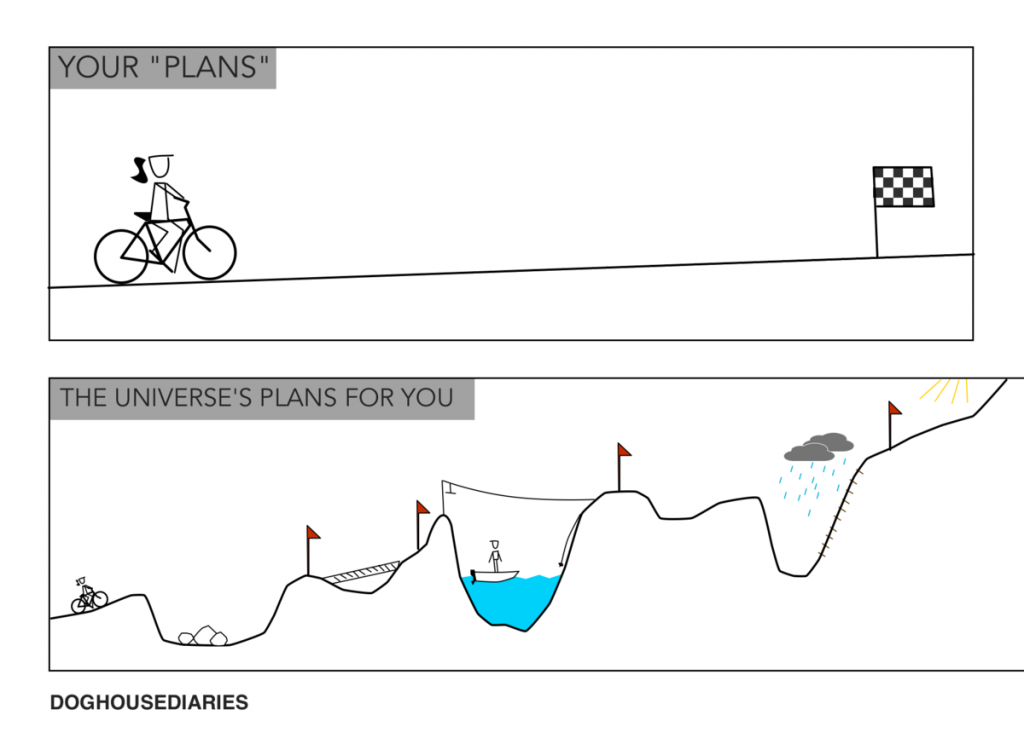
*My planning process in action.
best-laid plans of mice and men oft(en) go astray..
Prov. Things often go wrong even though you have carefully planned what you are going to do. ~Via The Free Dictionary
It’s the New Year. Your bright, shiny plan is in front of you ready to be executed on. You’re pumped. You have clarity (or some clarity at least).
This is going to be YOUR year.
Like any resolution or goal, the setting it part is fairly easy. You probably know exactly what needs to shift to make your business better. Perhaps you inherently know you played small in 2013, and you’re ready to show up in a bigger way this year. Or you didn’t have enough sales conversations to reach your revenue goals. Or, you didn’t focus on growing your community so your reach is still small. And now you’re resolved to create more money and more impact. No. Matter. What.
…
Until a few weeks pass and you’re already ‘off course’ with your plans. That elaborate launch hasn’t happened. The weekly newsletter you promised to send has only gone out once. Or the signature program you finally committed to creating is only partway through, meaning you’re going to have to bump out your launch date (again).
Welcome to the realities of planning.
While I’m a forever advocate of visioning and strategic planning, it isn’t without its challenges. Just because you get a plan on paper doesn’t mean it will go exactly according to plan. More times than not, it won’t. That’s where the phrase, “best-laid plans” came from. You are not alone here!
You may wonder if planning is even worth it then, yes? Fair point, but rest assured that planning is instrumental in the growth of your business. Here’s why:
- It requires that you get very mindful and attentive to the realities of your business (what’s working, what’s not) as opposed to sticking your head in the sand and hoping things will change. As they say in the corporate world, “What gets measured gets managed.”
- It gives you a direction to head in. While you may take a side road along the way, you first need to know where your intended destination is, otherwise, you’ve set up a vagabond business.
- It gives you something build on and anchor in. Without a plan, you’re essentially saying, “I’m winging this business and I’ll just hope that things work out accordingly.”
- It gives you permission to say NO to things that just aren’t a priority this year. Ah, freedom!
- And it keeps you on track and accountable to what matters most.
So having a plan is part of being the CEO of your business. It’s why the Boards of billion-dollar companies running strategic planning retreats every year. Can you imagine the CEO of Nike or Coke or Apple saying, “Bah, screw the plan. Let’s just wing it this year!” Of course not.
And…
The truth is, you aren’t Nike, Coke or Apple. You’re a small business owner that likely is either fully running your business by yourself, or with just a small part-time team to support you. That means, while you’re more agile and nimble than the big companies, you’re also more susceptible to challenges like:
- Bright Shiny Object Syndrome,
- The Itty Bitty Shitty Committee
- Burnout and overwhelm
- Personal circumstances that impact your business (e.g. kids, schedules, etc.).
So while you can have a beautiful, shiny, totally inspiring plan that you know if you followed would ROCK your business world (and your personal world as a bi-product), the REALITY can perhaps look more like this:
*Image via Mashable
Can you relate?
You’re probably nodding your head or giggling a bit looking at this image, and yet the truth is that when you’re actually experiencing that second reality – you’re probably not laughing much. Instead, this is the place where it all starts to feel really hard, you go into major self-doubt or resistance, and ultimately your future plans get sidelined because of your current reality.
Yes?
So how can you regroup, stay the course or get back on track when things go sideways? Here’s where to start:
1. First, understand that this ‘reality check’ IS going to happen at some point. If you can normalize that along the path to anything worth doing, you’re going to fall off course / get sidetracked/ get distracted/ change your mind etc, then it doesn’t have to MEAN so much when it happens. Instead of immediately going into a non-supportive story like, “Ugh – here I am again, I can never stay the course,” OR “Well – forget the rest. I totally suck and fell off track so I’m not cut out for this,” – you can simply say, “Ah – yes, I’m here. I’m here because I’m in the doing of my dream – not the visioning – and that sometimes feels hard. And I’m off track a bit and that’s ok. What do I need to pay attention to here, and how can I get back on track?”
2. Reach out for support. Whether it’s a friend/spouse / coach/mastermind colleague — share where you’re at and get a little empathetic support so you can move out of ‘self-blaming’ fast. A trusted friend or expert will remind you that you’re still fully capable of creating the business you want regardless of what’s transpired to date.
3. Come back to why you’re doing what you’re doing in the first place. What’s the end game? For example, many of our From Mags to Riches participants have felt the ‘grind’ when the magazine is just getting going or is mid-stream. For some, it might be the vulnerability that comes from reaching out asking others to be part of their project, or for others, it’s the back-and-forth with designers and contributors. This can send people into a “What was I thinking? I can’t pull this off!” But when they remember WHY they’re publishing this magazine – they can keep going. When they remember that, “Hey – I have a small list/community and to really have the impact I want to have plus become more profitable, I am using this magazine as a catalyst to my own success so I can keep this work alive,” they can get back on track.
4. Pay attention to what’s true. If your plans get sidelined by YOU (not by some extenuating out-of-your-control situation), do a quick debrief on why. And be brutally honest here because it’s really easy to justify / rationalize / excuse your way out of your dreams (e.g. I just needed a break). So the question I ask myself when I’m trying to get honest about why I’m not moving something forward or am stuck is, “What’s true? What’s just fear?” Sometimes what’s REALLY true is that we do need a break or need to take care of ourselves or rethink our offer. That’s fine if that’s truly true. But often, it’s more of an excuse veiled as the truth. Maybe that launch/program flopped and instead of figuring out why and adjusting, you decide that, “I actually really don’t want to run group programs.” Is that true? Or is it just the fear of failure rearing its head? Only you can be honest about your truth – but at the risk of sounding ridiculously cliche – it will set you free.
5. Recalibrate. It’s time to just get back on track. Pull out your plan, adjust accordingly – however big or small – and get moving again. Don’t let a distraction take out the rest of your year. FOCUS on your strategic priorities (we cover this in full in My PRO Plan) and get back at it. Your work matters and your business matters. Get back in the game and take what you’ve learned to keep going.





